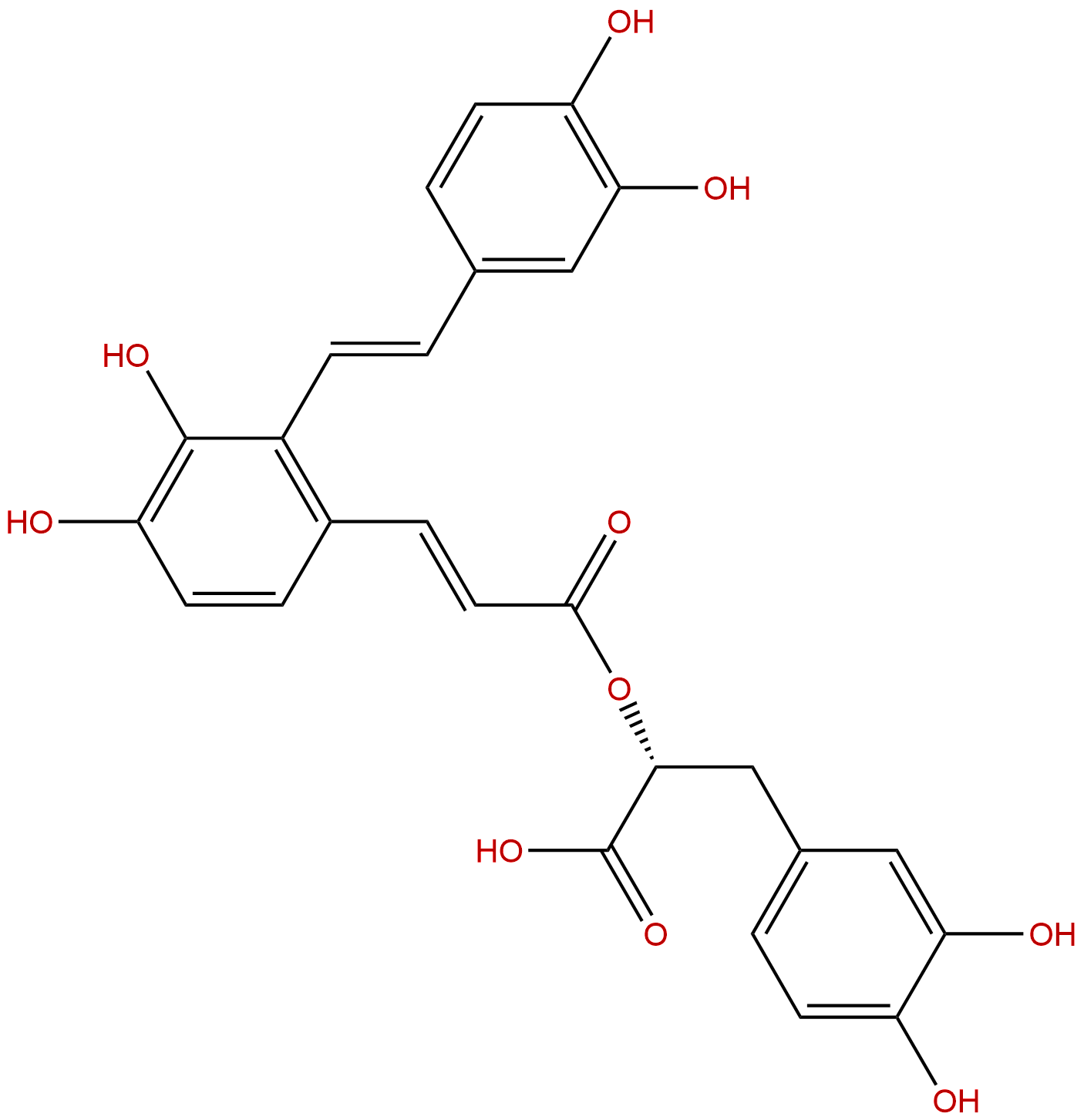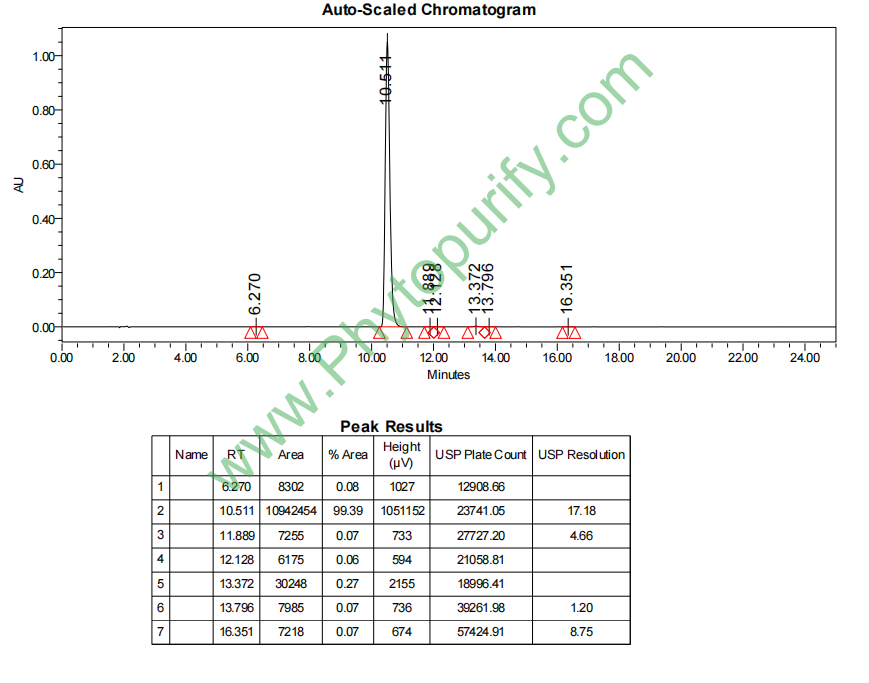
Salvianolic acid ACAS No.:96574-01-5 |
||||||||||
 |
|
|
||||||||

| Catalogue No.: | BP1247 |
| Formula: | C26H22O10 |
| Mol Weight: | 494.452 |
| Botanical Source: | Salviae Miltiorrhizae Radix et Rhizoma |
Product name: Salvianolic acid A
Synonym name:
Catalogue No.: BP1247
Cas No.: 96574-01-5
Formula: C26H22O10
Mol Weight: 494.452
Botanical Source: Salviae Miltiorrhizae Radix et Rhizoma
Physical Description:
Type of Compound: Stibene glucosides
Purity: 95%~99%
Analysis Method: HPLC-DAD or/and HPLC-ELSD
Identification Method: Mass, NMR
Packing: Brown vial or HDPE plastic bottle
Storage: Store in a well closed container, protected from air and light. Put into refrigerate or freeze for long term storage.
Whenever possible, you should prepare and use solutions on the same day. However, if you need to make up stock solutions in advance, we recommend that you store the solution as aliquots in tightly sealed vials at -20℃. Generally, these will be useable for up to two weeks.
The product could be supplied from milligrams to grams
Inquire for bulk scale.
Description:
Salvianolic acid A has antioxidant, hepatoprotective, antithrombotic effect, and antiplatelet actions. it also has a significant protective effect against isoproterenol-induced myocardial infarction; it activates the Nrf2/HO-1 axis in RPE cells and protects against oxidative stress via activation of Akt/mTORC1 signaling. Salvianolic acid A (oral) can significantly improve glucose metabolism and inhibit oxidative injury as well as protect against impaired vascular responsiveness in STZ-induced diabetic rats. It is a novel matrix metalloproteinase-9 inhibitor, can prevents cardiac remodeling in spontaneously hypertensive rats.
References:
Phytomedicine. 2014 Oct 15;21(12):1725-32.
Salvianolic acid A reverses paclitaxel resistance in human breast cancer MCF-7 cells via targeting the expression of transgelin 2 and attenuating PI3 K/Akt pathway.
Chemotherapy resistance represents a major problem for the treatment of patients with breast cancer and greatly restricts the use of first-line chemotherapeutics paclitaxel.
METHODS AND RESULTS:
The purpose of this study was to investigate the role of transgelin 2 in human breast cancer paclitaxel resistance cell line (MCF-7/PTX) and the reversal mechanism of Salvianolic acid A (SAA), a phenolic active compound extracted from Salvia miltiorrhiza. Western blotting and real-time quantitative polymerase chain reaction (qRT-PCR) indicated that transgelin 2 may mediate paclitaxel resistance by activating the phosphatidylinositol 3-kinase (PI3 K)/Akt signaling pathway to suppress MCF-7/PTX cells apoptosis. The reversal ability of SAA was confirmed by MTT assay and flow cytometry, with a superior 9.1-fold reversal index and enhancement of the apoptotic cytotoxicity induced by paclitaxel. In addition, SAA effectively prevented transgelin 2 and adenosine-triphosphate binding cassette transporter (ABC transporter) including P-glycoprotein (P-gp), multidrug resistance associated protein 1 (MRP1), and breast cancer resistance protein (BCRP) up-regulation and exhibited inhibitory effect on PI3 K/Akt signaling pathway in MCF-7/PTX cells. Taken together, SAA can reverse paclitaxel resistance through suppressing transgelin 2 expression by mechanisms involving attenuation of PI3 K/Akt pathway activation and ABC transporter up-regulation.
CONCLUSIONS:
These results not only provide insight into the potential application of SAA in reversing paclitaxel resistance, thus facilitating the sensitivity of breast cancer chemotherapy, but also highlight a potential role of transgelin 2 in the development of paclitaxel resistance in breast cancer.
J Ethnopharmacol. 2014 Sep 29;155(3):1589-96.Prevention of pulmonary fibrosis with salvianolic acid a by inducing fibroblast cell cycle arrest and promoting apoptosis.
Danshen (Salvia miltiorrhiza Bunge) is widely used in traditional Chinese medicine (TCM), often in combination with other herbs, to treat a diversity of ailments. More recent studies have focused on its possible roles in the treatment of respiratory diseases (pneumonia and pulmonary fibrosis) and found that it has pharmacological activity that protects pulmonary morphology and function. However, the mechanism underlying this activity has not yet been clarified.
METHODS AND RESULTS:
The purpose of this study was to investigate the anti-pulmonary fibrosis effects exerted by Salvianolic acid A (SAA), the ingredient responsible for the pharmacological activity of Danshen, and the underlying mechanisms. Bleomycin (BLM)-induced rat pulmonary fibrosis was used to evaluate the antifibrotic role of SAA, and fibroblast cells were used to study the mechanism involved. BLM-treated rats exhibited increased alveolar wall thickness and collagen deposition in lung tissues, but these pathologies were greatly attenuated by daily administration of SAA. We also found that SAA significantly inhibited the proliferation, adhesion and migration of fibroblasts in vitro. This was partly due to a strong induction of cell cycle arrest and apoptosis upon SAA treatment. Consistent with these phenotypes, we observed decreased expression of the cell cycle-related proteins cyclin D1, cyclin E1, and cyclin B1, and increased expression of p53 and p21 in SAA-treated cells. In addition, the anti-apoptotic Bcl-2 protein decreased in a dose-dependent manner, while cleaved caspase-3 protein increased upon SAA treatment.
CONCLUSIONS:
These results suggest that the alleviation of rat pulmonary fibrosis by SAA is due to the inhibition of fibroblast proliferation and induction of apoptosis, which occurs mainly through p53-dependent growth arrest and apoptosis. We suggest that SAA should be considered as a potential novel therapeutic agent for the treatment of fibrotic lung diseases.
HPLC of Salvianolic acid A
